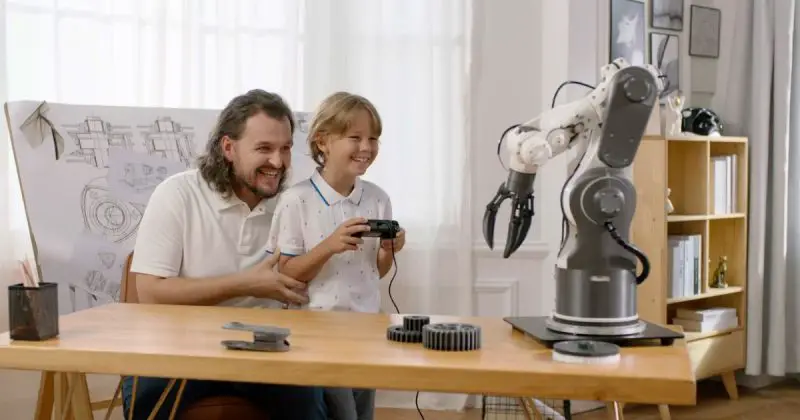Entering 2025, the concept of a personal robot capable of managing tasks, assisting in the home, and providing companionship has evolved from science fiction to reality. Personal robots are now becoming integral to daily life, offering enhanced convenience, productivity, and well-being. Advancements in artificial intelligence (AI), robotics, and machine learning have paved the way for more intelligent and adaptable robots, capable of handling a wide range of tasks, from household chores to complex problem-solving. This article explores the cutting-edge innovations in personal robotics, key players in the field, and the transformative impact these robots are poised to have on daily life and work.
The Rise of Personal Robots: From Science Fiction to Reality
Robots have been a staple of science fiction for decades, portrayed as futuristic helpers that assist with everything from housework to companionship. In the early 2000s, the concept of personal robots became more tangible with products like robotic vacuum cleaners and robotic lawnmowers. However, it’s only in recent years—thanks to advancements in AI, machine learning, and robotics—that personal robots are beginning to fulfill their potential as versatile, highly functional assistants.
Key Technologies Behind Personal Robots
- AI and Machine Learning: Make personal robots tick—they’re the brains behind the bots. In 2025, robots will be equipped with advanced machine-learning algorithms to learn from interactions and adapt to their users’ preferences and environments. This ability to learn makes personal robots more effective and efficient over time.
- Computer Vision: Robots today can see and understand their surroundings with remarkable accuracy. Using computer vision, they can navigate around objects, recognize faces, and even detect environmental changes—skills crucial for cleaning, organizing, and providing security.
- Natural Language Processing (NLP): Advanced NLP algorithms enable robots to understand and respond to voice commands in a more human-like manner. Whether providing information, offering assistance, or engaging in conversation, robots today are becoming more proficient in understanding human speech and intent.
- Robotics and Mobility: Modern robots are equipped with state-of-the-art sensors and motors, enabling them to exhibit mobility and dexterity comparable to that of humans. From walking and running to precise movements for tasks like folding laundry, robots’ mechanical capabilities are steadily improving.
Top Personal Robots of 2025: Transforming Home and Office Assistance
The landscape of personal robots is evolving rapidly, with numerous companies introducing robots that simplify daily life in ways once unimaginable. Some of the most notable robots of 2025 are revolutionizing the way individuals live, work, and interact with technology.
1. Tesla Optimus: The Human-Like Assistant
The Tesla Optimus robot is designed as a humanoid assistant capable of performing various tasks. It can do everything from delivering groceries and cleaning the house to offering customer support and managing complex work processes.
- Features: Human-like mobility with advanced walking and dexterous hand movements. Integration with Tesla’s AI system, enabling it to adapt and learn user preferences. Full voice command compatibility and intuitive interaction.
- Why It’s Great: Tesla Optimus represents the pinnacle of humanoid robots, combining Tesla’s expertise in AI and robotics. It can seamlessly blend into everyday life, whether you need it to run errands or assist in your home office.
2. iRobot Roomba 9900: The Future of Smart Vacuuming
iRobot’s Roomba 9900 series takes smart cleaning to the next level. With advanced sensors and AI-driven mapping, the Roomba 9900 can precisely navigate your home, learning the layout and adjusting its cleaning patterns accordingly.
- Features: AI-powered mapping and room-specific cleaning capabilities. Voice-activated features let personal robots act like personal assistants, working with your home devices to simplify daily routines. Equipped with an advanced filtration system, it effectively removes allergens and dust particles for cleaner air.
- Why It’s Great: The Roomba 9900 is more than just a vacuum; it’s an intelligent cleaning assistant that can learn the layout of your home and make adjustments for optimal cleaning. With intelligent mapping and precision control, it cleans thoroughly—every corner, every time.
3. Amazon Astro: The Household Assistant Robot
Amazon’s Astro robot is designed to serve as a home assistant, offering functionality and entertainment. It can handle household chores, monitor security, and provide virtual companionship.
- Features: Integrated with Amazon Alexa for seamless smart home control and entertainment. They recognize faces and track movement, allowing for more personalized and responsive interactions, sensors for obstacle detection, and efficient navigation through the home.
- Why It’s Great: Astro perfectly combines practicality and entertainment. It can help you set reminders, play music, and even deliver messages across the home while monitoring security.
4. Temi Personal Robot: Your Mobile Assistant
Temi is a mobile personal robot designed to be a faithful assistant. It can follow you around the house or office, provide real-time information, and even help with scheduling and organization.
- Features: Autonomous navigation with obstacle avoidance. Face recognition and voice command functionality. High-definition video calling for remote interactions.
- Why It’s Great: Temi’s ability to follow users and interact on the move makes it one of the most versatile personal robots. It’s perfect for a dynamic environment at home or in the office.
5. Honda Asimo: The Service Robot of the Future
Honda’s ASIMO is a humanoid robot that assists in public environments, including healthcare, hospitality, and customer service. It offers help with everyday tasks while interacting naturally with people. It can carry items, help customers, and even provide entertainment.
- Features: Advanced mobility with walking, running, and dancing abilities. Facial and voice recognition for personalized interactions. Capable of lifting and carrying objects of varying sizes.
- Why It’s Great: Asimo represents a leap forward in humanoid robots designed for public and professional environments. Its ability to interact with people in real time and assist with physical tasks makes it an invaluable asset in the service industry.
Personal Robots in the Home: Streamlining Everyday Life
The home environment is where personal robots are having the most immediate impact. From cleaning and organizing to cooking and even providing companionship, robots in the home are designed to relieve the burden of mundane tasks, allowing individuals to focus on what truly matters.
Home Cleaning Robots
- Robot Vacuums and Mops: Robots like the Roomba 9900 and Roborock S7 have made cleaning effortless. With smart sensors, mapping systems, and automatic scheduling, these devices eliminate the hassle of cleaning and navigating the layout of your home, ensuring optimal coverage.
- Laundry Folding Robots: The FoldiMate and Laundroid are examples of robots designed to fold clothes. These robots efficiently organize a clean laundry pile, saving time and effort.
Security Robots
Monitoring and Surveillance: Robots like the Ring Always Home Cam provide advanced security features, offering real-time video surveillance, movement detection, and notifications to keep your home safe. These robots can patrol your home autonomously, providing enhanced security and peace of mind when you’re away.
Companion Robots
- Elderly Assistance: Robots like ElliQ are designed to assist elderly individuals with daily activities, from reminding them to take medication to providing entertainment and companionship. These robots serve as a bridge, helping older adults maintain their independence while staying connected to loved ones.
Personal Robots in the Workplace: Boosting Productivity and Efficiency
Robots in the workplace are transforming industries by automating routine tasks, enhancing productivity, and enabling human workers to focus on more complex and creative activities. The possibilities are endless, from digital administrative assistants that manage your schedule to specialized robots that assist surgeons in the operating room.
Administrative and Office Assistance
- Virtual Office Assistants: Robots like Temi and Aido are designed to assist with tasks such as scheduling, email management, and even video calls. They can move around the office and assist employees in various tasks, acting as personal assistants who enhance workplace productivity.
Healthcare Robots
- Surgical Robots: Robots like the Da Vinci Surgical System are already transforming surgery, providing precision and allowing for minimally invasive procedures. Personal robots may assist with pre-operative care, patient monitoring, and even post-operative rehabilitation.
Warehouse Robots
- Automation in logistics is revolutionizing supply chains, with robots, such as autonomous warehouse systems from Ocado and Amazon Robotics, leading the way. These robots efficiently pick and pack goods at impressive speeds, optimizing logistics and reducing the need for manual labor.
The Ethical and Social Implications of Personal Robots
While the rise of personal robots offers numerous benefits, ethical considerations must also be addressed. Privacy concerns, the potential for job displacement, and the broader societal implications of widespread automation are crucial issues that must be addressed.
Privacy and Data Security
As robots become more integrated into our lives, they gather vast amounts of personal data. This raises significant concerns about how that data is collected, stored, and used, particularly regarding privacy, consent, and cybersecurity. Transparent data policies, encryption, and ethical guidelines will ensure that personal robots respect user privacy.
Job Displacement
Automating tasks traditionally performed by humans could lead to significant job displacement across specific industries, particularly in roles that involve repetitive or routine tasks. While robots can increase productivity, businesses must consider the broader social implications, such as how to reskill workers whose jobs are replaced by automation.
Human-Robot Interaction
As robots become more human-like, the distinction between machine and human interaction grows increasingly blurred, raising questions about the nature of relationships and emotional connections with AI. This shift challenges our understanding of empathy, socialization, and the role of technology in everyday life. Understanding how to foster healthy and ethical interactions with robots, particularly in sensitive environments such as healthcare, is crucial to ensuring that robots are used responsibly.
Personal Robots in 2025 and Beyond
The future of personal robots is inspiring. As AI advances and robots become increasingly adept at performing a wider range of tasks, they will continue to integrate further into homes and workplaces. With increasing emotional intelligence, these robots will be capable of responding to human emotions and providing support in mental health contexts. As their autonomy increases, personal robots will assume more complex roles, making life easier and more efficient.
In 2025, personal robots will transcend their roles as simple assistants. They will become companions, problem-solvers, and productivity boosters, enhancing daily life with improved efficiency, safety, and emotional well-being. As technology continues to evolve, these robots will be even more integrated into daily routines, transforming the way people work, live, and interact with the world. With their expanding capabilities, personal robots will shift from futuristic concepts to everyday essentials.





